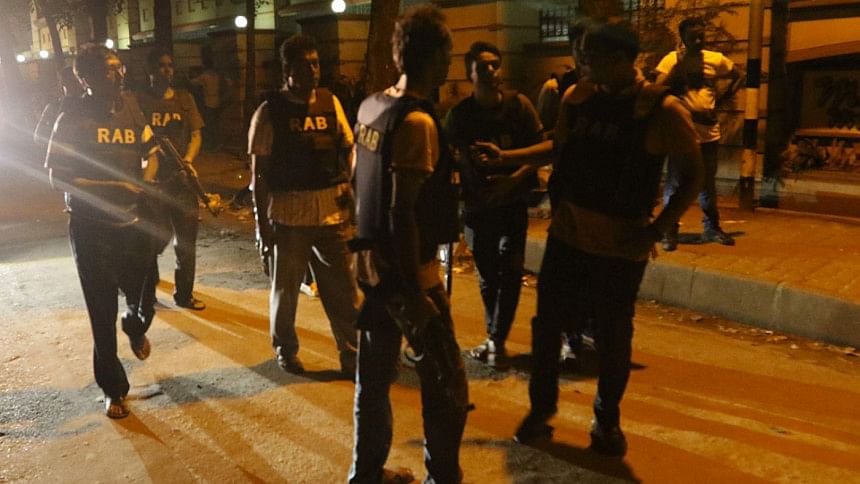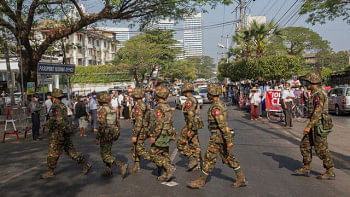Bangladesh's 7/16

Not since the gruesome killings of BDR officers had we been faced with such a heart rending situation. And this was the first time that the country has faced a hostage situation in forty years, the last was in 1977 when a Japan Airline Flight 472 was hijacked by the Japanese Red Army and flown into Dhaka on 28 September. But that was an entirely different ball game. In that instance we were caught totally unawares with no previous experience of bargaining with hostage takers. However, the negotiations in 1977 were conducted in the most professional manner and the matter fortunately ended without any casualty.
This time too, it seems that the police was caught unawares since the situation they encountered on Friday evening, and which lasted for nearly 12 hours, they had never faced before in recent times. Unfortunately, not all the hostages could be saved. The question is whether the law enforcing agencies should have been caught off guard. They could not have been unaware of the fact that the IS' call to its cohorts around the world to go after the 'infidels' in the month of Ramazan would be picked up in Bangladesh too. And given that there was a spike in the number of targeted killings in the last three months, responsibility of which was claimed by the IS in each of the killings, except for one, something like this should have been anticipated. It seems too that in spite of the much flaunted road checks and heightened security of the diplomatic area, the killers should have been able to slip through the police cordon not only with arms and weapons but also a sword.
What was the aim of the hostage takers one is not sure. There was no demand that we know of as yet that the terrorists made in exchange for the hostages. It was therefore interesting to see the approach of the DG Rab to seek negotiations with the terrorists. One wonders till how long he persisted with his effort, but given that the assailants had not made any demands it should have been clear from the outset that seeking a peaceable solution was not an option. Apparently, it was also not a simple kill-as-many-as-you-can and run action. Apparently it was a suicide mission, with no intention of going back. The choice of target is also significant, it being one frequented by foreigners.
The gruesome manner of killing of the hostages bears the hallmark of the IS. Interestingly, both the IS and Al Qaeda have claimed responsibility of the killings but one is not sure as to whether the killers are indeed organically linked to either of the terror groups.
One wonders too what the terrorist have achieved by killing the helpless people. While one is not sure that these people are organically linked to the international extremist groups but the government must own up to the reality that the footprints of the IS in this country is very real and no amount of denying can alter the fact.
Apparently, the army was called in, the exact time of requisitioning the army one is not aware, after the first assault by Rab had floundered. It is my assessment that most of the casualties suffered by the police were at the very initial phase of the hostage situation when an attempt was made to rush the building. That was done at a time when the police was not completely cognizant of the actual situation inside the building including about the number of terrorist holding out and the number of hostages they were holding. The police wanted to surprise the terrorists but unfortunately they were themselves surprised, and it was at that time that they were caught in the terrorist fire particularly hand grenades. But unfortunately, much of the killings of the hostages might have been carried out well before the investment of the army. The commandos managed to rescue 13 hostages and kill all but one of the terrorist and capture one.
It is a natural question in the public mind whether the rescue operation could have been launched sooner and whether more of the hostages could have been rescued alive. In a hostage situation like we encountered Friday night, there are two things that are most vital in considering the course of action and fixing the time of launching the rescue operation. First is the question of time. While the inclination is to go for action immediately since the lives of the hostages are involved, rushing is fraught with danger since ingress into the building must be very carefully planned. There must be reliable intelligence about the terrorists and about the building they are holding out in. And this, one would have hoped, would have been done by the first of the forces to have arrived on the spot, i.e. the police, as part of advance planning.
The second consideration is the weight of the force that could be brought to bear on the target area. Given that it was a built up area, use of heavy weapons could not be made without risking incurring collateral damage to property and life. And the security forces could not go in without a fairly good idea of the layout of the building, particularly the configuration of the rooms and where the hostages were being held. Doing otherwise might have risked more lives. And that information could be got from anyone of the staff of the hotel /bakery who had managed to escape.
We hope we would not be remiss in asking if there is a crisis management group that would take up the central command and coordination in times of a situation like the one we have just encountered. If not then there should be one that can assess the situation and initiate actions to save time and lives.
One wishes that the security forces could have saved all the hostages, but we are sure there was no dearth of effort to do so. Our condolences and heartfelt sorrow for those brave policemen who put their life in line of fire to save the hostages and for all the unfortunate hostages killed in the Holey Bakery.
The writer is Associate Editor, The Daily Star.

 For all latest news, follow The Daily Star's Google News channel.
For all latest news, follow The Daily Star's Google News channel. 



Comments